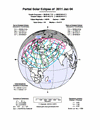- - text and links as of last publication - -
![]()
| CAUTION! OBSERVING A SUN ECLIPSE IS DANGEROUS AND MAY CAUSE IRREVERSIBLE EYE DAMAGE, UP TO BLINDNESS, ANNULAR AND PARTIAL ECLIPSES INCLUDED! Observing a Sun eclipse necessitates DEDICATED SAFE TECHNIQUES! |
That first solar eclipse in 2011 occurs as soon as by January 4th as it is a partial solar one, visible in a area extending from northwestern Africa and Europe to Pakistan and central Russia. A partial solar eclipse occurs when neither the 'umbra' nor the 'antumbra' of the eclipse touches Earth in any place as the 'penumbra' does, only. For that eclipse, the 'umbra' is passing a mere 317 miles (510 km) above the Earth surface! Anywhere in the area of eclipse, observers will be treated with a Sun indented by the dark disk of the Moon! for more about the solar eclipses, theoretically, see our tutorial "Sun Eclipses"
As the eclipse's greatest is occurring at 08:50:34 UT, the largest indented Sun is seen North of the area where the partial eclipse is running. From Scandinavia down to the Mediterranean Sea, a percentage of between 85 and 80 percent of the Sun will be masked. The farther South, the eclipse the less important, with, eventually, less than 20 percent of the Sun eclipsed from northwestern Africa to northwestern China. Europe is having the eclipse by sunrise, as Russia and Central Asia by sunset
 | The January 4th, 2011 Partial Solar Eclipse as it will look like as seen from Praha, Czech Republic. picture site 'Amateur Astronomy', based on Stellarium |
Eclipse's main data are the following (data as of November 2010, F. Espenak, NASA/GSFC). The Moon's apparent diameter will be of 30' 36.2", compared to the Sun's 32' 31.8". for more about how to observe a solar eclipse, see our tutorial "Observing a Sun Eclipse ":
- greatest eclipse: 08:50:34.9 UT
- eclipse magnitude (fraction of the Sun's diameter obscured by the Moon at greatest eclipse): 0.8576
- P1 to P4 (moments of first-last external-internal tangency of the penumbra with Earth's limb; practically these are the moments of the eclipse for the places where the eclipse is partial); in UT: P1 at 06:40:11.3, P2 at 11:00:53.7 (no P2 nor P3 times as the cone of the penumbra is not entirely contained upon Earth's disk)
 | see a map for the January 4th, 2011 Partial Solar Eclipse. map courtesy Fred Espenak - NASA/GSFC |
. for more about this eclipse and for more about solar and lunar eclipses generally, you may see at Fred Espenak's NASA's eclipse website
Observation Reports: albeit Europe was supposedly favored with the eclipse greatest, weather could not afford for observation as southernmost parts of Europe, North Africa, Moscow or Israel could see the eclipse
Website Manager: G. Guichard, site 'Amateur Astronomy,' http://stars5.6te.net. Page Editor: G. Guichard. last edited: 1/1/2011. contact us at ggwebsites@outlook.com